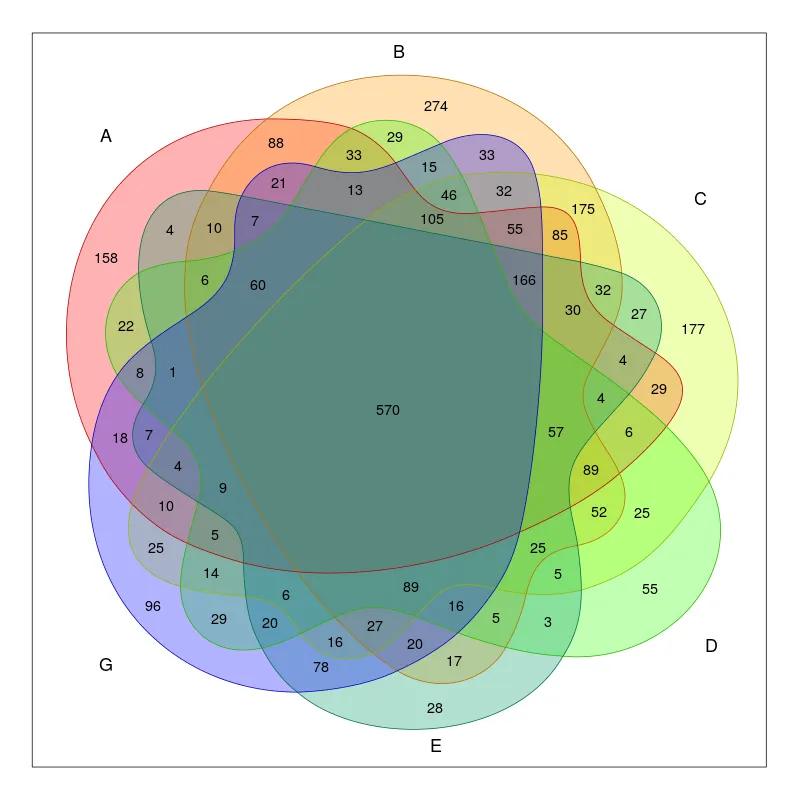我最近看到一篇很好的五组文氏图,如下:
有没有人知道如何用 R 编写生成这样文氏图的代码?
我查看的大多数软件包似乎生成了不太清晰的版本:
有什么想法吗?
编辑:看起来 Nature 文章使用了这个 Web 工具:http://bioinformatics.psb.ugent.be/webtools/Venn/ 可能将其移植到某些 R 包中仍然不错,尤其是目前任何我知道的软件包中都没有的非对称文氏图。
我最近看到一篇很好的五组文氏图,如下:
有没有人知道如何用 R 编写生成这样文氏图的代码?
我查看的大多数软件包似乎生成了不太清晰的版本:
有什么想法吗?
编辑:看起来 Nature 文章使用了这个 Web 工具:http://bioinformatics.psb.ugent.be/webtools/Venn/ 可能将其移植到某些 R 包中仍然不错,尤其是目前任何我知道的软件包中都没有的非对称文氏图。
library(venn)
venn(5, ilab=TRUE, zcolor = "style")
venn(7, ilab=TRUE, zcolor = "style")
我还在Ghent大学生物信息学网站上使用了在线的Venn图生成器,我也想要自己的函数。当然,想法是让每个交集区域的大小合理,以便计数的文本可以是相同的大小。这里是我的尝试:
fiveCellVenn <- function(colorList=col2rgb(rainbow(5)),
cellCounts=seq(1,31,1),
cellLabels=c("one","two","three","four","five"),
saturation=.25){
rotateVec <-function(vec,amount){
return(c(vec[(amount+1):length(vec)], vec[1:amount]))
}
n=70
xhull <- c()
yhull <- c()
for (i in 1:n){
xhull <- c(xhull, cos((i*2*pi)/n))
yhull <- c(yhull, sin((i*2*pi)/n))
}
## The Venn cells begin as a 70-sided regular polygon
## plot(xhull, yhull)
## polygon(xhull, yhull)
## Multiply each unit vector in the hull by a scalar, arrived at by
## iterative adjustment.
adjust <-c(10,10.35,10.6,10.5,10.4,10.3,10.1,9.6,9,8.5,
8,7.625,7.25,7.125,7,6.875,6.75,6.875,7,7.125,
7.25,7.625,8.1,9.125,10.25,11.375,12.5,13.15,13.8,14.3,
14.6,14.725,14.7,14.7,14.7,14.4,14.1,13.8,13.5,12.8,
12.1,11.15,10.2,9.6,8.95,8.3,7.7,7,6.25,5.6,
5,4.75,4.5,4.25,4,3.8,3.6,3.45,3.45,3.45,
3.5,3.625,3.75,3.825,4,4.25,4.5,5.75,7.25,8.5)
newxhull <- xhull*adjust
newyhull <- yhull*adjust
## Text location was also done by hand:
textLocationX <- c(-13,-3,8,9,-4,-7.5,7.5,-9,-8,4,6.5,-2,9,-4,1.4,4,-7.5,-3.5,7.5,-6,-6.5,6,1.5,4,-0.5,4.5,0,-5,-3.5,3.5,0)
textLocationY <- c(1,12,8,-8,-12,6.5,4.5,1,-4,8.5,-6,8.5,-1.5,-8,-9,5,3.5,6,1.5,-6,-1.5,-2,8,-7,-6.5,2,5.5,2,-3.5,-4,0)
textLocationMatrix <- matrix(cbind(textLocationX,textLocationY),nrow=31,ncol=2)
plot(newxhull, newyhull, pch=".", xlim=c(-16,16), ylim=c(-16,16),
axes=FALSE,xlab="",ylab="")
newAdjust<-adjust
for (i in 1:5){
newxhull <- xhull*newAdjust
newyhull <- yhull*newAdjust
polygon(newxhull, newyhull,
border=rgb(colorList[1,i]/255, colorList[2,i]/255, colorList[3,i]/255, 1),
lwd=2,
col=rgb(colorList[1,i]/255, colorList[2,i]/255, colorList[3,i]/255,saturation))
newAdjust <- rotateVec(newAdjust,14)
}
text(textLocationMatrix[,1], textLocationMatrix[,2],labels=as.character(cellCounts))
text(textLocationMatrix[c(17,2,3,24,14),1]*c(2,1.25,1.5,2,2),
textLocationMatrix[c(17,2,3,24,14),2]*c(2,1.35,1.5,2,2),
labels=cellLabels)
## uncomment and run to get points and grid for adjusting text location
## points(textLocationMatrix[,1], textLocationMatrix[,2])
## for (i in -16:16){
## if (i%%5==0){
## color="black"
## }else{
## color="lightblue"
## }
## abline(v=i,col=color)
## abline(h=i, col=color)
## }
}
那么
fiveCellVenn()
使用上述代码可以生成类似于第一个Venn图。我还没有足够的声望来发布图片。您可能需要减弱颜色并移动单元格名称。
library(venn); library(tidyverse); library(stringr);
p_th = 0.0;
data <- read_csv("finaldf.csv")
data
venn =
list(A =
data %>%
filter(CVA > p_th) %>%
.$phrase,
B =
data %>%
filter(IHD > p_th) %>%
.$phrase,
C =
data %>%
filter(CM > p_th) %>%
.$phrase,
D =
data %>%
filter(ARR > p_th) %>%
.$phrase,
E =
data %>%
filter(VD > p_th) %>%
.$phrase,
G =
data %>%
filter(CHD > p_th) %>%
.$phrase);
png("ven.png", width = 800, height = 800)
venn.result =
venn(venn, ilabels = TRUE,
zcolor = "style", size = 25, cexil = 1.2, cexsn = 1.5);
dev.off()
6个集合的维恩图

dput(data) 来使其更有用和可重现性? - Tungfinal_df.csv 文件长什么样? - user2110417